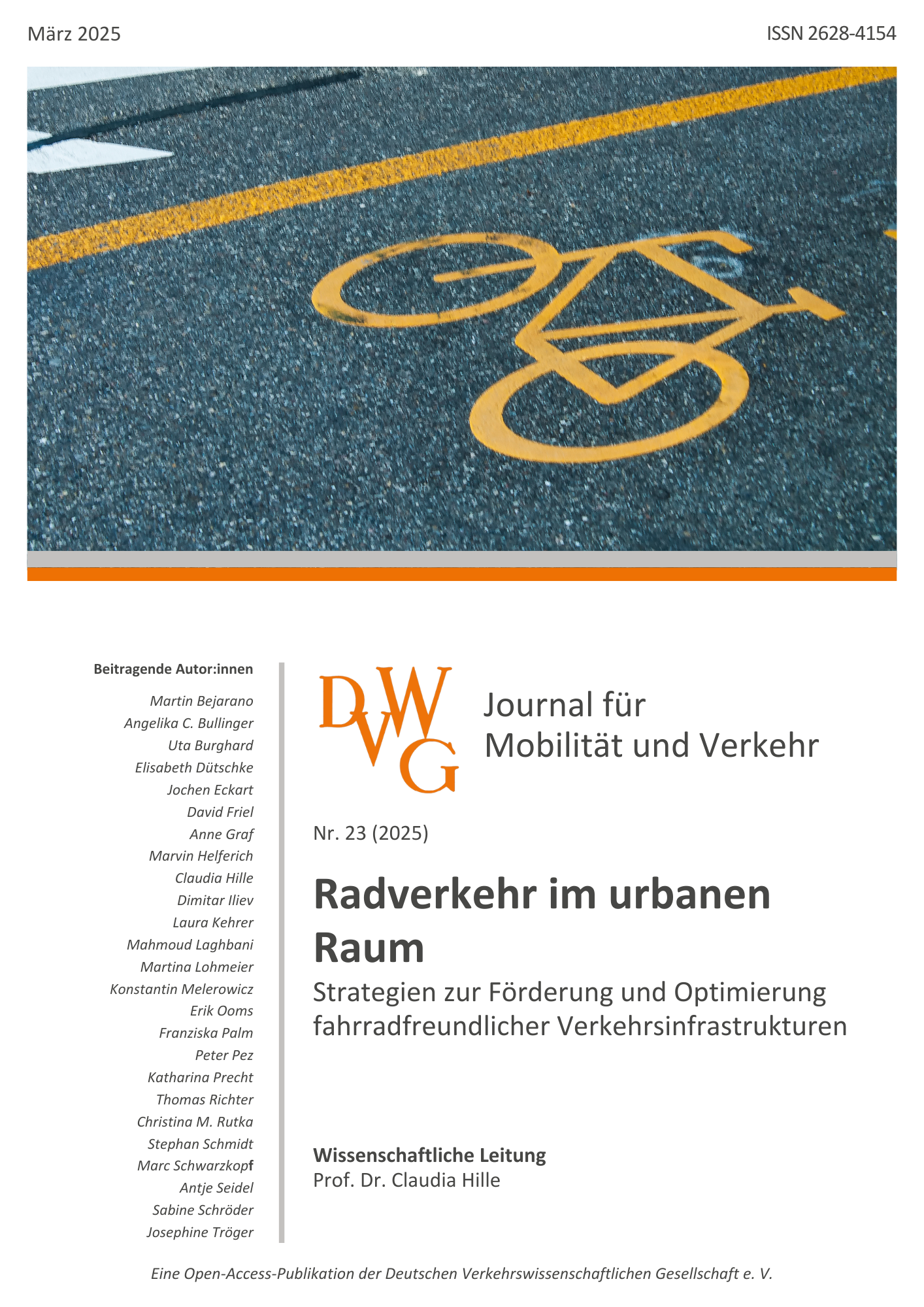Von der Angst zur Akzeptanz: Mit Virtueller Realität die subjektive Sicherheit von Radfahrinfrastruktur erfassen und verbessern
DOI:
https://doi.org/10.34647/jmv.nr23.id187Schlagworte:
Virtual Reality, Subjektive Sicherheit, Fahrradverkehr, Infrastrukturplanung, Bürgerpartizipation, Extended RealityAbstract
In Deutschland wird Radfahrinfrastruktur selten systematisch auf subjektive Sicherheit evaluiert, sicherheitsrelevante Mängel werden so häufig nicht identifiziert und wiederholt. Diese Studie untersucht den Einsatz von Virtual Reality zur Bewertung der subjektiven Sicherheit im Radverkehr. Die Ergebnisse zeigen, dass VR eine realitätsnahe, intuitive und praktikable Methode zur Evaluation der subjektiven Sicherheit von Radfahrinfrastruktur darstellen kann und wertvolle Erkenntnisse für die Verkehrsplanung und Bürgerbeteiligung liefert.
Literaturhinweise
Alrutz, D., Gündel, D., Busek, S., Vullriede, N., Brünink, N. & Hagemeister, D. (2016): Landeshaupt-stadt München - Evaluierung Fahrradstraßen - Schlussbericht. https://muenchenunterwegs.de/content/1104/download/evaluierung-fahrradstrassen-schlussbericht-final.pdf
Bogacz, M., Hess, S., F. Choudhury, C., Calastri, C., Mushtaq, F., Awais, M., Nazemi, M., van Egger-mond, M. & Erath, A. (2021): Cycling in virtual reali-ty: modelling behaviour in an immersive environ-ment. Transportation letters, 13(8), 608-622. https://doi.org/10.1080/19427867.2020.1745358
https://doi.org/10.1080/19427867.2020.1745358
Graser, A., Aleksa, M., Straub, M., Saleh, P., Wittmann, S. & Lenz, G. (2016). Safety of Urban Cycling: A Study on Perceived and Actual Dangers. In G. Yannis & S. Cohen (Hrsg.), Traffic Safety (S. 145-159). Wiley. https://doi.org/10.1002/9781119307853.ch10
https://doi.org/10.1002/9781119307853.ch10
Graystone, M., Mitra, R. & Hess, P. M. (2022): Gendered perceptions of cycling safety and on-street bicycle infrastructure: Bridging the gap. Transportation Research Part D Transport And Environment, 105, 103237. https://doi.org/10.1016/j.trd.2022.103237
https://doi.org/10.1016/j.trd.2022.103237
Huemer, A. K., Rosenboom, L. M., Naujoks, M., & Banach, E. (2022): Testing cycling infrastructure layout in virtual environments: An examination from a bicycle rider's perspective in simulation and online. Transportation research interdisciplinary perspectives, 14, 100586. https://doi.org/10.1016/j.trip.2022.100586
https://doi.org/10.1016/j.trip.2022.100586
Korbion, H., Mantscheff, J., & Vygen, K. (2021): Honorarordnung für Architekten und Ingenieure (HOAI).
Lim, T., Thompson, J., Tian, L. & Beck, B. (2023). A transactional model of stress and coping applied to cyclist subjective experiences. Transportation Re-search Part F: Traffic Psychology and Behaviour, 96, 155-170. https://doi.org/10.1016/j.trf.2023.05.013
https://doi.org/10.1016/j.trf.2023.05.013
Manton, R., Rau, H., Fahy, F., Sheahan, J., & Clifford, E. (2016): Using mental mapping to unpack perceived cycling risk. Accident Analysis & Preven-tion, 88, 138-149. https://doi.org/10.1016/j.aap.2015.12.017
https://doi.org/10.1016/j.aap.2015.12.017
PMid:26760689
Lawson, A. R., Pakrashi, V., Ghosh, B. & Szeto, W. Y. (2013): Perception of safety of cyclists in Dublin City. Accident
https://doi.org/10.1016/j.aap.2012.05.029
PMid:22683279
analysis and prevention, 50, 499-511. https://doi.org/10.1016/j.aap. 2012.05.029
https://doi.org/10.1016/j.aap.2012.05.029
PMid:22683279
Schläger, N., Wührl, B., Woywod, T., Fromberg, A., Gwiasda, P., & Niklas, K. (2016): Sicherheitsbe-wertung von Fahrradstraßen und der Öffnung von Einbahnstraßen (No. 41). https://rad.sh/wp-content/uploads/2022/03/02-Unfallforschung-der-Versicherer.pdf
Schwarzkopf, M., Dettmann, A., Heinz, A., Miethe, M., Hoffmann, H. & Bullinger, A.C. (2023): Let's Use VR! A Focus Group Study on Challenges and Opportunities for Citizen Participation in Traffic Planning. HCII 2023, Part I, LNCS 14048. https://doi.org/10.1007/978-3-031-35678-0_24
https://doi.org/10.1007/978-3-031-35678-0_24
Schwarzkopf, M., Dettmann, A., Hoffmann, H., & Bullinger, A. C. (2024): Immersive urban planning: Infusing virtual reality into citizen participation for amplified engagement and sustainable planning. HFES, Lübeck. https://www.hfes-europe.org/wp-content/uploads/2024/05/Schwarzkopf2024.pdf
Stülpnagel, R. von & Binnig, N. (2022): How safe do you feel? - A large-scale survey concerning the subjective safety associated with different kinds of cycling lanes. Accident; analysis and prevention, 167, 106577. https://doi.org/10.1016/j.aap.2022.106577
https://doi.org/10.1016/j.aap.2022.106577
PMid:35123280
Schwedes, O., Wachholz, S., & Friel, D. (2021): Sicherheit ist Ansichtssache. Subjektive Sicherheit: Ein vernachlässigtes Forschungsfeld (No. 2021 (1)). IVP-Discussion Paper. https://www.econstor.eu/bitstream/10419/229189/1/1745157107.pdf
Winters, M., Babul, S., Becker, H. J. E. H., Bru-bacher, J. R., Chipman, M., Cripton, P., ... & Tesch-ke, K. (2012): Safe cycling: how do risk perceptions compare with observed risk?. Canadian journal of public health, 103, S42-S47. https://doi.org/10.1007/BF03403834
https://doi.org/10.1007/BF03403834
PMid:23618088 PMCid:PMC6974276
Wolf, M., Söbke, H., Wehking, F. (2020): Mixed Reality Media-Enabled Public Participation in Urban Planning. In: Jung, T., tom Dieck, M.C., Rauschnabel, P.A. (eds) Augmented Reality and Virtual Reality. Progress in IS. Springer, Cham. https://doi.org/10.1007/978-3-030-37869-1_11

Downloads
Veröffentlicht
Ausgabe
Rubrik
Lizenz
Copyright (c) 2025 Marc Schwarzkopf, Katharina Precht, Angelika C. Bullinger

Dieses Werk steht unter der Lizenz Creative Commons Namensnennung - Nicht-kommerziell - Keine Bearbeitungen 4.0 International.

